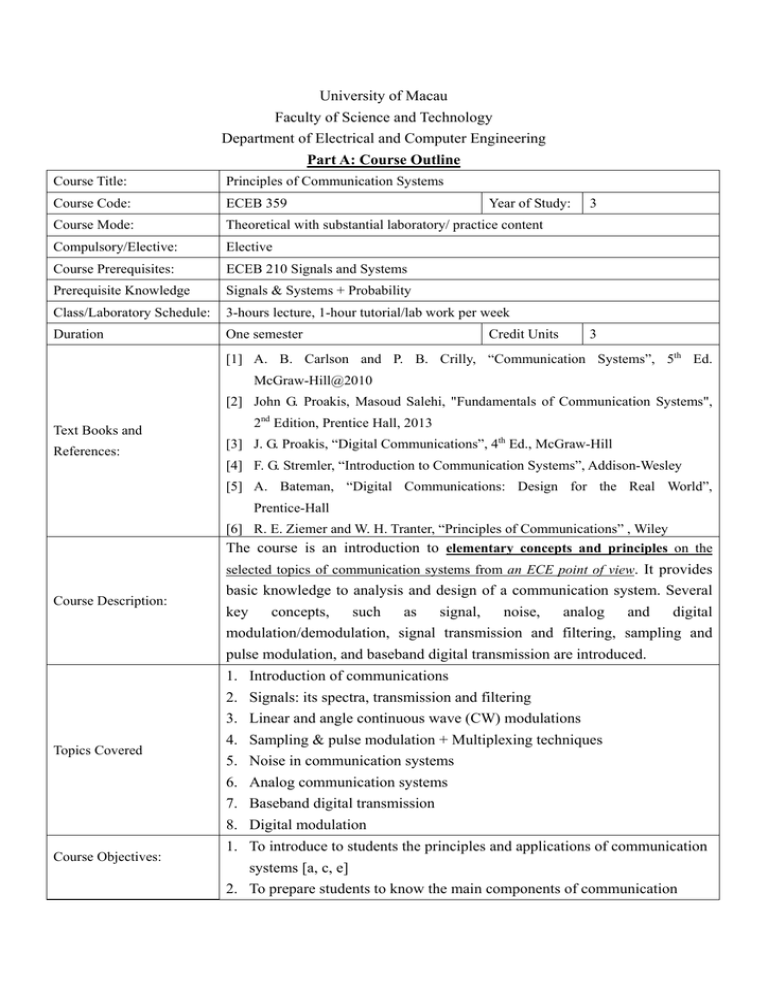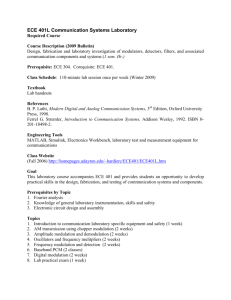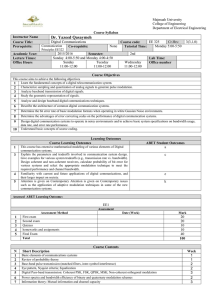ECEB359 - University of Macau, Faculty of Science and Technology
advertisement

University of Macau Faculty of Science and Technology Department of Electrical and Computer Engineering Part A: Course Outline Course Title: Principles of Communication Systems Course Code: ECEB 359 Course Mode: Theoretical with substantial laboratory/ practice content Compulsory/Elective: Elective Course Prerequisites: ECEB 210 Signals and Systems Prerequisite Knowledge Signals & Systems + Probability Class/Laboratory Schedule: 3-hours lecture, 1-hour tutorial/lab work per week Duration One semester Year of Study: Credit Units 3 3 [1] A. B. Carlson and P. B. Crilly, “Communication Systems”, 5th Ed. McGraw-Hill@2010 [2] John G. Proakis, Masoud Salehi, "Fundamentals of Communication Systems", Text Books and References: 2nd Edition, Prentice Hall, 2013 [3] J. G. Proakis, “Digital Communications”, 4th Ed., McGraw-Hill [4] F. G. Stremler, “Introduction to Communication Systems”, Addison-Wesley [5] A. Bateman, “Digital Communications: Design for the Real World”, Prentice-Hall [6] R. E. Ziemer and W. H. Tranter, “Principles of Communications” , Wiley The course is an introduction to elementary concepts and principles on the selected topics of communication systems from an ECE point of view. It provides Course Description: Topics Covered Course Objectives: basic knowledge to analysis and design of a communication system. Several key concepts, such as signal, noise, analog and digital modulation/demodulation, signal transmission and filtering, sampling and pulse modulation, and baseband digital transmission are introduced. 1. 2. 3. 4. 5. 6. 7. 8. Introduction of communications Signals: its spectra, transmission and filtering Linear and angle continuous wave (CW) modulations Sampling & pulse modulation + Multiplexing techniques Noise in communication systems Analog communication systems Baseband digital transmission Digital modulation 1. To introduce to students the principles and applications of communication systems [a, c, e] 2. To prepare students to know the main components of communication systems and their corresponding characteristics/functions [a, b, c, e, k, l] Course Assessment: Assignments: 15%, Simulation Projects and Experiments: 15% Mid-term Exam. : 20% Final Exam. : 50% This course primarily contributes to ECE program outcomes that develop students abilities to: a. Ability to apply knowledge of mathematics, science and engineering. c. Ability to design a system, component or process to meet desired needs. e. Ability to identify, formulate and solve engineering problems. Relationship to Program Objectives and Outcomes This course secondarily contributes to ECE program outcomes that develop students abilities to: b. Ability to design and conduct experiments. k. Ability to use the techniques, skills and modern engineering tools necessary for engineering practice. l. Ability to use the computer/IT tools relevant to the discipline along with an understanding of their processes and limitations Week no. 1 2 Course Contents and Relationship to Program Criteria: 4 2 1 4 Topics Introduction Overview of communications Signals: its spectra, transmission and filtering Fourier transform, time and frequency relations, signal distortion in transmission, correlation and spectral density Linear and angle CW modulation + Analog communication systems Bandpass signal & systems, various AM and FM techniques, frequency conversion, super-heterodyne techniques Sampling and pulse modulation + Multiplexing techniques Sampling theory, quantization, FDMA, TDMA, CDMA, SDMA Noise in Communication systems Random variables, system noise calculations Baseband digital transmission + Digital modulation Baseband digital transmission, key components in digital communication systems, ASK, PSK, FSK, QAM Program Criteria ES, BS, DIC, ES, CS, PS ES, CS, DE, DIC ES, CS, ES, CV, PS LA, CV, PS, DM Contribution of Course to meet the professional component: This course prepares students to work professionally in the area of communications related fields. Students should be able to apply knowledge of mathematics and engineering, and identify formulas to solve engineering problems. Course Instructor(s): Dr. Ma, Shaodan, et al. Prepared by: Dr. Ma, Shaodan Part B: General Course Information and Policies Instructor: Dr. Ma, Shaodan Office: Office Hour: Monday 2:00-4:00 p.m. or by appointment Phone: E-mail: shaodanma@umac.mo E11-3047 8470 Programme Educational Objectives 1. Problem Solving: Graduates have the ability to think in a critical and evaluative manner and to consider a broad perspective, in order to solve technical and nontechnical problems. 2. Leadership and Communication: Graduates will provide effective leadership, act in an ethical manner and possess the abilities to communicate well and to work successfully within diverse groups. 3. Market Acceptance: Graduates will have successful careers in the academic environment, industrial and government organizations. 4. Technical Competence: Graduates will be technically competent and have a thorough grounding in the fundamentals of math and science in electrical and electronics engineering and experience in engineering design. They will be able to use modern engineering techniques, skills, and tools to fulfill societal needs. Scale: 1 (Highest) to 4 (Lowest) Principles Problem Leadership and Market Technical Solving Communication Acceptance Competence 3 1 of 1 3 Communication Systems Remarks: Objective for “Problem Solving” can be achieved by assignments, quizzes, mid-term exam, final exam and projects. Objective for “Leadership and Communication” can be achieved by report writing and presentation. However, leadership training is not given by this course. Objective for “Market Acceptance” can be achieved by the course subject that is related to communication systems. Objective for “Technical Competence” can be achieved by using fundamentals of math and science in electrical and electronics engineering and experience in engineering project design and computer simulation. Program Criteria Policy: Course VS Program Criteria Scale: 1 (Highest) to 4 (Lowest) Course Principles of Communication Systems PS DIC BS CS ES DE LA CV DM 1 1 2 3 1 4 2 1 3 Terms: Probability and Statistics (PS), Differential and Integral Calculus (DIC), Basic Science (BS), Computer Science (CS), Engineering Science (ES), Differential Equation (DE), Linear Algebra (LA), Complex Variables (CV), Discrete Mathematics (DM) Relationship of Course to Programme Outcomes: Course VS Course Outcomes *T – TEACH; P – PRACTICE; M – MEASURED Program Outcomes ECEB359 a b c T P TP d e f g h i j k l Principles of Communication Systems P The outcomes of electrical and computer engineering program are: a. Ability to apply knowledge of mathematics, science and engineering. b. Ability to design and conduct experiments. c. Ability to design a system, component or process to meet desired needs. d. Ability to function on multidisciplinary teams. e. Ability to identify, formulate and solve engineering problems. P P f. Understanding of professional and ethical responsibility. g. Ability to communicate effectively. h. Broad education necessary to understand the impact of engineering solutions in global and societal context. i. Recognition of the need for and an ability to engage in life-long learning. j. Knowledge of contemporary issues. k. l. Ability to use the techniques, skills and modern engineering tools necessary for engineering practice. Ability to use the computer/IT tools relevant to the discipline along with an understanding of their processes and limitations Curriculum Detail ECEB 359 Principles of Communication Systems Timetabled work in hours No of per week teaching Total hours Lecturer Tutor Practice weeks 3 0.5 14 0.5 56 No /Duration Max marks of exam available from: papers Exams Course 2/5 hours 70 30 Term: 5th Hours Lecture Percentage content of Lab/tut Other Mathematics and Engineering Subjects Basic Sciences 42 7/7 0 40 50 Complementary Computer Studies Studies 0 10 Design Elements Please use an "X" to indicate the presence of the specific elements in the course/module/subject. Design Content in Design Project(s) Design Content in Course Work Laboratories X X Course Assessment Policy: Assignments will be given to students according to the course progress. No late submission of homework is accepted. Zero mark will be given when homework is copied. Some experiments will be performed during the semester. Two/Three students form one group and group report should be handed in. Commercial software shall be used in simulations. One mid-term exam and one final exam will be performed with 2 hours and 3 hours respectively.


